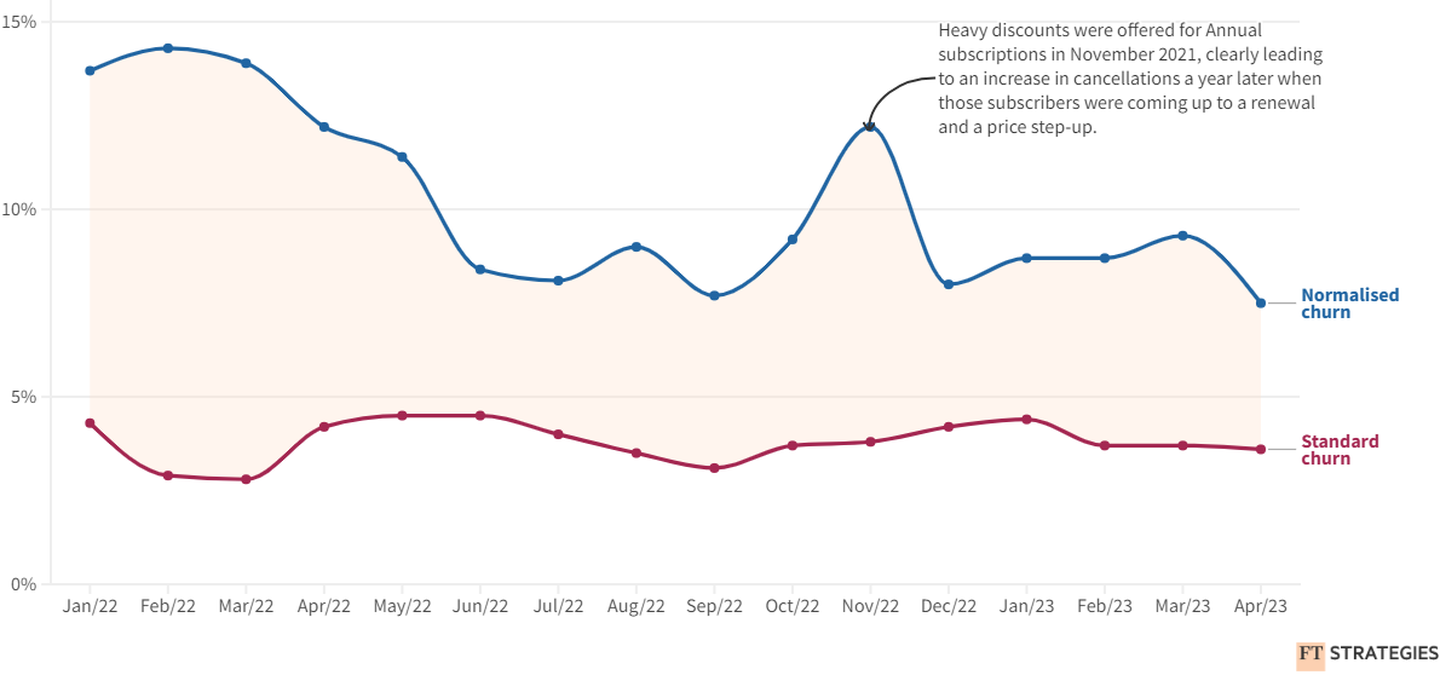'Churn rate’ is the most important, and yet often unhelpful, metric for a media subscription business.
Important because a reduction in churn is the quickest way to grow subscription revenue without incurring unnecessary costs.
Unhelpful because churn is a deeply aggregated metric that describes something that: a) has already happened (and is now largely beyond control) and b) doesn’t tell you why it has happened.
It is for that reason that churn rate should be just one of a suite of ‘metrics that matter’ within your organisation. In this blog post, we explain ‘normalised churn rate’ which is one of the rarely used complimentary metrics which can provide you with a new perspective on the performance of your subscription business.
What is normalised churn rate? And how can it be useful?
In our experience, most publishers use a fairly simple and common formula to measure their standard churn rate on a monthly basis:


In this example we show that if ACME Daily had 200 subscribers active at the end of October and 10 cancelled in November, their churn rate in November would be 5% (10/200).
The difference with a normalised churn rate is that it only takes into account the number of renewals that were due in the timeframe as the baseline (as opposed to the total number of active subscribers).


Therefore, going back to the example above, if only 50 subscribers were due to renew in November (out of the 200 that were active at the end of October), we’d have a normalised churn rate of 20% (10/50)
This allows subscription businesses to differentiate between whether any changes in their churn rate are the result of limiting the number of renewals or improving the actual renewal rate. It’s important that you distinguish between those two factors and measure them as they are often the responsibility of different parts of the organisation.
For example, acquisition teams often have the ability to change what subscriptions are offered on the paywall or landing page. This gives them the power to limit the number of renewal periods by offering and promoting longer term subscriptions with lower renewal frequency (e.g. bi-annual or annual). Our experience shows that this as an approach can reduce the churn rate by 8-10x and significantly increase the average lifetime value of your subscriber.
On the other hand, retention teams are often responsible for ensuring that the renewal process is as seamless as possible. This gives them the power to adapt the pre, during and post renewal communications and renewal process writ-large to maximise the actual renewal rate. Our experience shows that small improvements to the renewal process (that reduce churn by 0.1%) can translate to hundreds of thousands of pounds of saved lifetime value over a long period.
Below is a real example of how standard churn and normalised churn might look if run in parallel. Normalised will always be higher (or at least equal) than the standard as it is only looking at a subset of your audience, those that are due to renew in the month, and it is not affected by your subscribers base growth.
Monthly churn rate(s)


As highlighted in the chart, users that were due to renew in November 2022 cancelled at a much higher rate than those renewing in adjacent months, reflecting the poor retention rate of annual subscribers that were first acquired in November 2021 via heavy acquisition discounting. This additional layer of insight can help teams across the organisation identify key areas of weakness that require additional attention in future.
For the sake of completeness, it’s worth noting:
- In the rare case where a publisher only offers monthly subscriptions, the two curves should pretty much align and the pink-shaded area would disappear.
- Similar information can be retrieved by producing survival curves and breaking them down by acquisition cohorts, though these might be harder to produce and won’t necessarily give you a sense of how churn evolves historically over time.
Next steps
Tackling churn doesn’t end here. Having a clear definition of the issue and a way of appropriately sizing it up are just the starting point.
Understanding what the main drivers of churn are and trying to combat or remove them are the natural next steps. This can be done in different ways that can get more and more sophisticated, such as:
- Collecting opinions or anecdotal insights across your various teams
- Asking your audience during the cancellation flow
- Running a more in-depth readers’ research project
- Analysing your data to uncover historical patterns that might help predicting the future
At FT Strategies we’ve got experience across all these areas, from delivering foundational insights and supporting metrics, to implementing propensity modelling and experimentation, which will ultimately enable your teams to be much more targeted and effective. Here are some results we delivered together with one of our clients.
Please get in touch if you would like to discuss this further.
About the author

